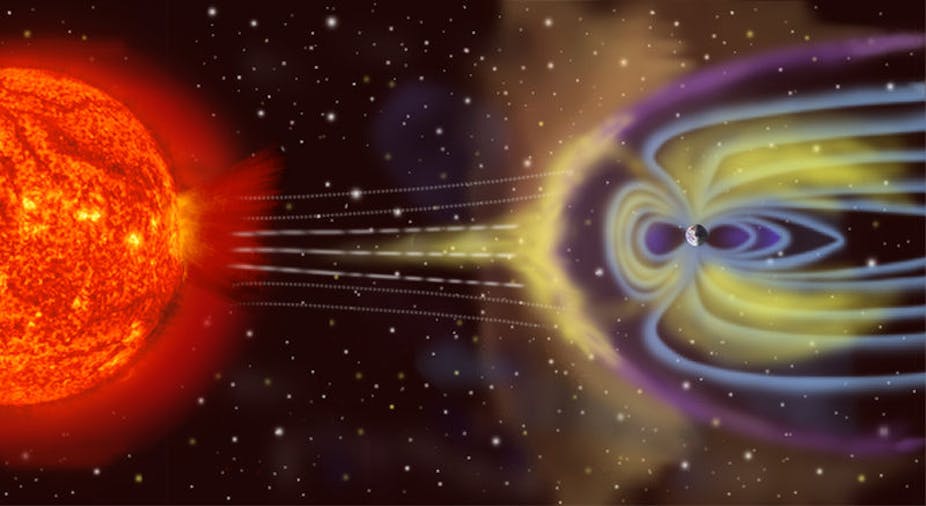In the past week, many media outlets have reported the discovery of an antimatter “belt” circling the earth.
A range of potential uses for this belt have already been floated – perhaps the most exciting of which is the possibility of it being employed to fuel future space missions.
But before we can understand how antimatter might be used as fuel, we need to understand what antimatter actually is and where this particular belt was found.
What happened?
The antimatter belt is confined to the inner regions of Earth’s magnetosphere – the area of space around Earth that extends oval-like for many thousands of kilometres, created during the interaction of the solar wind and the earth’s magnetic field.
This rather startling finding, published in online journal arXiv in late July, confirms earlier theoretical predictions of the presence of antiprotons trapped in “orbit” above Earth by the planet’s magnetic field.
So what are antiprotons?
Well, almost all particles in our matter world also have antiparticles – particle doppelgangers that, according to our best physical theories, have the same mass but opposite charge to their matter counterparts.
The most common examples of these are the positron – the positive antiparticle to the ubiquitous (negative) electron – and the aforementioned antiproton – the negative antiparticle to the positively charged proton.
The antiprotons in the antimatter belt are thought to be produced by interactions between the cosmic ray flux – streams of energetic particles, mostly electrons and protons – with matter in the upper atmosphere.
The resultant negatively-charged antiprotons then effectively become trapped in motion along the magnetic field lines of the earth (see image below), assuming their kinetic energy and relative angle to the field lines are such that they cannot “escape” across those field lines.

The discovery of these trapped antiprotons was made using a satellite-borne instrument known as PAMELA (Payload for Antimatter/Matter Exploration and Light-nuclei Astrophysics).
PAMELA – which is monitored by a multinational research collaboration – was designed to measure the flux of particles and their antiparticles in the region between 350 kilometres and 610 kilometres above Earth’s surface.
One of the key findings made by physicists working with PAMELA was that the trapped antiprotons spiral around the earth’s magnetic field lines and likely bounce between mirror points – points where the shape of the field causes the particles to reverse their motion.
Surprisingly, it only took the discovery of 28 trapped antiprotons with kinetic energies less than 1 million electron volts over more than 800 days in satellite orbit for the researchers to declare the existence of a “belt”.
While the density of antiprotons discovered is incredibly low, it is still several orders of magnitude in excess of what might be “normally” expected in the interstellar medium – the “stuff” between solar systems in a galaxy – in the absence of Earth’s strong magnetic field.
Space vs Lab
The finding provides an interesting contrast to the terrestrial, man-made antiproton “traps” found in laboratories such as CERN in Switzerland – the European Organisation for Nuclear Research.
In such experiments, antiprotons are used for the production and study of antihydrogen atoms – a combination of an antiproton and a positron – as opposed to the proton and electron combination in a “conventional” hydrogen atom.
Among other things, these laboratory studies hope to reveal if there are any subtle differences between the properties of matter and antimatter, aside from the obvious difference in charge.
One such recent experiment by the ALPHA collaboration at CERN successfully trapped hundreds of antihydrogen atoms for up to 15 minutes.
The density of antiprotons in these man-made traps is many orders of magnitude higher than was observed in the magnetospheric “trap” – so in this case, nature still has a long way to go to catch up to the big (and expensive) science being done in labs around the world.
Rocket fuel
So how could this antimatter belt be used to power future space craft?
Well, the theory is that antiprotons from the belt around Earth could be harvested, fed into a specially-built reactor on board a space craft where they would then mix with protons.
The resulting interaction would result in the annihilation of both protons and antiprotons, creating highly energetic photons which would then be used to propel the craft.
Is this possible? Well yes, but probably not in the near future. We are a long, long way from the sort of numbers of antiprotons that would be required for such a space fuel source.
But the newly discovered belt, far from constraining future endeavours, will help scientists, and their science, to expand considerably.

